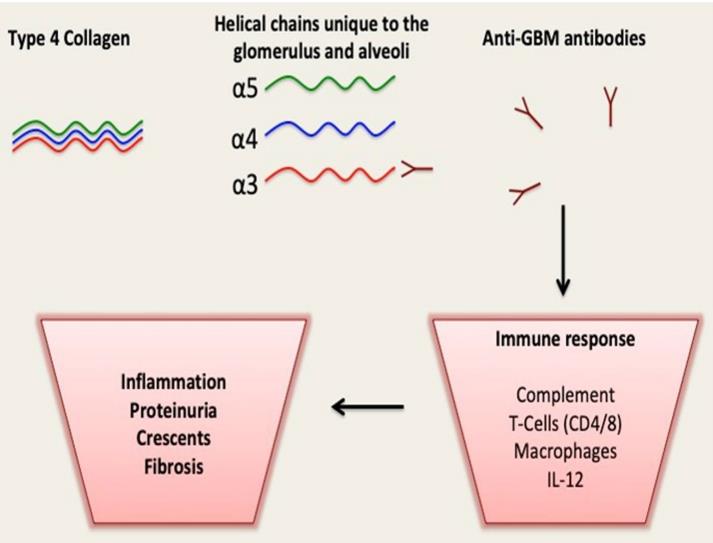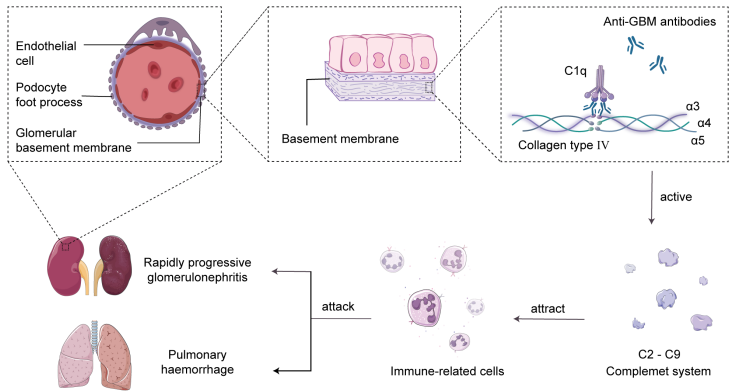NAA Services for Anti-Glomerular Basement Membrane (GBM) Antibody
The abnormality of anti-glomerular basement membrane (GBM), a natural autoantibody, can lead to renal diseases. As a world-leading biological company dedicated to human health research, Creative Biolabs has bent ourselves to anti-GBM autoantibody and related NAA researches for many years. Our objective is to provide the best and professional solutions and services to our customers throughout the world.
Background of Glomerular Basement Membrane (GBM)
The glomerular basement membrane (GBM) is an especially thick, non-cellular layer basement membrane of the glomerular filtration barrier that separates the vasculature from the urinary space. The GBM situating between the glomerular endothelial cells and the podocytes forms a three-layered structure - endothelial cells, GBM, and podocyte, determining the filtration function of the glomerulus. Similar to other basement membranes, GBM is an extracellular matrix component primarily composed of four types of macromolecules: laminin, type IV collagen, heparan sulfate proteoglycan, and nidogen.
Anti-glomerular basement membrane antibody (anti-GBM) is an autoantibody that attacks GBM and causes kidney damage. Anti-GBMs generally are IgG type and can be normally detected by ELISA in the circulation. GBM autoantibodies are able to target the antigens on basement membranes of both pulmonary and renal vasculature, which are associated with a group of renal diseases and pulmonary diseases.
 Fig.1 The autoimmune production of anti-GBM antibodies and the subsequent inflammatory response.1
Fig.1 The autoimmune production of anti-GBM antibodies and the subsequent inflammatory response.1
The Role of Anti-Glomerular Basement Membrane (GBM) Antibody in Lung Hemorrhage Nephritis Syndrome (Goodpasture Syndrome)
Lung hemorrhage nephritis syndrome, also known as Goodpasture Syndrome and anti-GBM disease, is a rare and life-threatening disorder that was firstly described in 1919. Goodpasture syndrome is an autoimmune disease caused by pathogenic autoantibodies directly targeting autoantigens expressed in the basement membranes of both lungs and kidneys, leading to bleeding from the lungs and kidney failure. These autoantibodies mainly specifically target for the alpha-3 chain of type IV collagen of basement membranes and activate the complement cascade causing cell death. Autoantibody against GBM, especially the IgG1 type targeting alpha-3 subunit of type IV collagen, is the definite pathogenic cause of the Goodpasture Syndrome, which can provide reliable help for early diagnosis.
 Fig.2 The development of acute glomerulonephritis and pulmonary hemorrhage syndrome caused by self-anti-GBM antibodies in the human glomerular basement membrane.2
Fig.2 The development of acute glomerulonephritis and pulmonary hemorrhage syndrome caused by self-anti-GBM antibodies in the human glomerular basement membrane.2
What We Can Do for You About NAA Services?
Creative Biolabs can provide comprehensive NAA services (including NAA detection, NAA profiling, affinity measurement, NAA mapping, etc.) aided by our well-established platforms and experienced scientists.
Besides, Creative Biolabs is also capable to provide the best and diversity of products and services about NAA. Our proven and optimized platforms can help you quickly get satisfactory results without repeated trials. We also provide custom services based on the requirements of the clients to meet specific demands. Please contact us for more information.
References
- Dowsett, Thomas, and Louise Oni. "Anti-glomerular basement membrane disease in children: a brief overview." Pediatric Nephrology 37.8 (2022): 1713-1719.
- Tang, Anqi, et al. "Unleashing the power of complement activation: unraveling renal damage in human anti-glomerular basement membrane disease." Frontiers in Immunology 14 (2023): 1229806.

